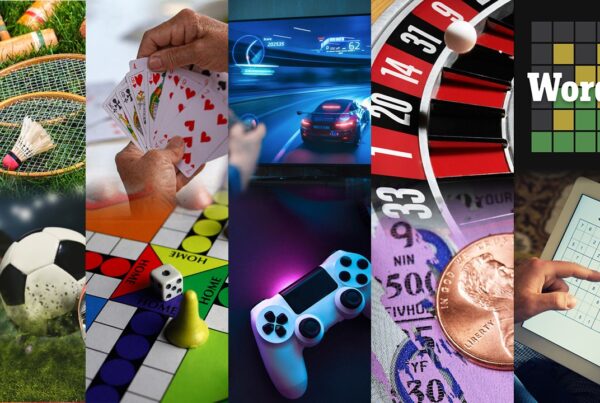Games and gamification aren’t the same. With games, you have rules, competitive play, and a determination of skill. Gamification, on the other hand, takes game-like mechanics and applies them to things that aren’t games (like sales training) as a method for developing and practicing certain skills. In addition to effectively teaching skills, it lets us tap into a number of human inclinations like socialization, mastery, and achievement, which reinforce learning.
One of gamification’s most significant characteristics in the corporate training environment is that it’s more light-hearted than a traditional lecture, slide deck, or video. And when new skills and behaviors that may seem dull are made fun of, the learning environment becomes more engaging and effective.
The concept of gamifying processes dates back to 2002 when British computer programmer Nick Pelling coined the term, which went mainstream in 2009 with the Foursquare social app. Pelling simply defines the concept as applying a game-like user interface design that makes interaction with an app fast-paced and fun. When you apply the fun elements of games to real-world training initiatives, the results can be impressive.
The Ingredients That Make Gamification Effective
Humans are motivated to perform actions or demonstrate certain behaviors in return for the feeling of being rewarded, which is typically characterized by the brain’s release of the neurotransmitter dopamine. During a positive game-play experience, dopamine is released, and humans find this enjoyable. Motivation, along with mastery and “triggers” are three key ingredients in gamifying effectively.
Motivation, intrinsic and extrinsic, is about our reasons for behaving in a certain way, and if you remember your Psych 101 and the “stimulus-response” paradigm, gamifying processes make sense if you’re thinking about external motivation. Intrinsic motivation can be introduced with social gaming aspects, such as team challenges.
Mastery is about assimilating the knowledge and skills necessary to accomplish a task. People enjoy the feeling of getting better at something, whether it’s cooking, catching Pokemon, or developing sales skills. We like being challenged, as we are with games that increase in difficulty as we surpass successive levels.
Triggers that initiate a positive feedback mechanism help people form habits and hone skills, and are essential to games that develop real skills. Effective triggers help block out distractions, encourage people to try things in a safe environment, and make them believe they’re capable of achieving an end goal.
Learning Outcomes Include a Sense of Empowerment
The use of custom games in training leads to many positive outcomes, and one of the most important of those outcomes is the sense of empowerment that develops along with game mastery. People who “burn out” at work tend to be those who do not feel like they have the right tools for their job, and when gamified training empowers people with the tools they need, they go from feeling they’re riding a rusty old bike with squeaky training wheels to feeling like they’re on a brand new titanium-framed bike with aligned steering, perfect gear ratios, and brakes that work as intended.
Why Gamification Is a Good Fit for Sales Training
Sales training, in particular, is a good candidate for gamified learning for several reasons. For one thing, sales professionals tend to be competitive, and gamification allows them to direct those competitive tendencies in a positive way. Furthermore, the right training provider will offer targeted data collection and analytics that give trainers the data they need to be confident team members are learning what they’re expected to learn for maximum long-term benefit. An excellent gamified training module can tell trainers, for example, that “Player B took longer to conclude the virtual sales call, but made a bigger sale, for a higher return on time invested.”
In many situations, friendly competition and rewards like badges, or places on a leader board keep sales teams motivated and moving forward too. Group sharing and collaboration, say, by using points to ask other players for input can keep gamified learning from becoming cutthroat and overly competitive while allowing other players the opportunity to demonstrate their own knowledge.
Benefits of Gamification in Sales Training
Other benefits of gamified aspects of sales training include:
- Preventing the need to “cram” knowledge of new products due to the efficacy of “bite-sized” interval learning
- Creation of a proper balance of competition and camaraderie
- Enabling retention and application of information and skills
- Provision of analytics and reporting that are useful for sales trainers
- Creation of virtual scenarios with appropriate and relevant context for real-world selling
Benefits of Gamification in Sales Training Other
As exciting as the prospect of gamifying the sales training environment can be, it’s important not to put all your eggs in one basket. Yes, it’s a terrific tool, but it’s only one of many, and you can’t expect one learning modality to do all the heavy lifting. What’s more, varying learning tools by including synchronous and asynchronous lessons, lessons that engage different learning styles, and a variety of testing methods help ensure you address every learner’s best learning style, and that nobody is left behind. While eLearning in general, and gamification in particular, are tremendously powerful, flexible, and effective, trainers must resist the temptation to present all new information in a single learning modality.
If you’re looking for the right time to introduce gamified elements to your sales training environment, there’s no better time than the present. As a component of a multifaceted learning program, it offers something fun, new, and engaging that teaches and reinforces information and skills. Custom training games can be a more cost-effective investment than you might realize, too, since they can not only engage learners effectively but also provide real-time or near real-time data on learner progress. Finally, learning games can appeal to the competitive spirit without becoming dispiriting, provided they incorporate social elements that bring team members together to help each other succeed.
If you want to learn more about gamification and other training tools, we invite you to have a look at our blog content. You’re sure to find some powerful ideas for making your sales training program its most effective.





